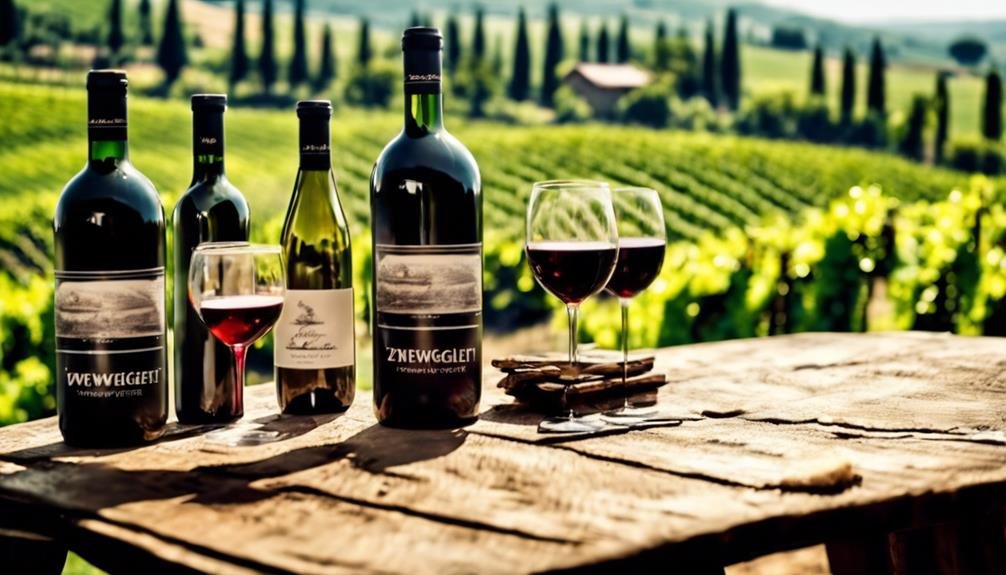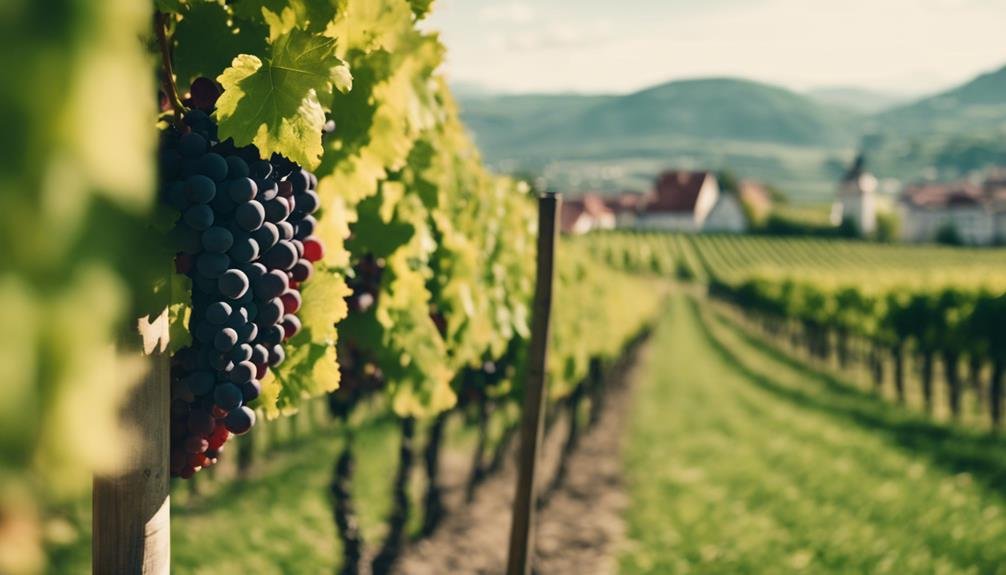Embark on a flavorful journey through Austrian wine regions, offering diverse grape varieties for every palate. In the north, Grüner Veltliner reigns with herbaceous and peppery notes, a versatile match for various dishes. Explore the south for exceptional red wines like Zweigelt, boasting cherry flavors and aging potential for complexity. Dive into Blaufränkisch with its age-worthy nature and unique blackberry-citrus blend, ideal with grilled foods. Discover St. Laurent as a refined Pinot Noir alternative, aging into dark berry-spice nuances. Each sip uncovers Austria's terroir in a bottle, promising a delightful experience for wine enthusiasts seeking new horizons.
Austrian Wine Regions and Varieties
Austria's wine regions showcase a diverse array of grape varieties, with a focus on Grüner Veltliner in the north and exceptional red wines in the south. Austrian wine terroir plays a significant role in shaping these distinct flavors.
The northern regions benefit from cooler climates, ideal for producing the crisp and zesty Grüner Veltliner, known for its herbaceous notes. In contrast, the southern regions with warmer temperatures excel in crafting rich and robust red wines like Blaufränkisch.
Unique wine pairings elevate the tasting experience, with Grüner Veltliner complementing sushi and cilantro-driven dishes. On the other hand, Blaufränkisch pairs harmoniously with rich, grilled foods such as BBQ tenderloin.
These regional characteristics and unique wine pairings make Austrian wines a delightful discovery for wine enthusiasts.
Characteristics of Grüner Veltliner
With its distinct herbaceous and zesty profile, Grüner Veltliner stands out as a notable varietal in Austria's diverse wine landscape. Here are some key characteristics of Grüner Veltliner:
- Herbaceous Profile: Grüner Veltliner is known for its unique herbaceous notes, often described as peppery, with hints of green herbs like arugula and celery seed.
- Versatile Food Pairings: This wine pairs exceptionally well with a variety of dishes, including sushi, cilantro-driven dishes, and spicy cuisines due to its peppery and invigorating profile.
- Acidity and Freshness: Grüner Veltliner is characterized by racy acidity and a invigorating quality, making it a popular choice for those who enjoy vibrant and lively white wines.
Exploring Zweigelt Wines

Exploring the unique characteristics of Zweigelt wines reveals a delightful blend of cherry flavors and moderate acidity. This light red wine benefits from decanting, which enhances its fruitiness.
When considering food pairings, traditional Austrian dishes or American fare like chicken tenders complement Zweigelt wines exceptionally well.
Regarding flavor profiles, expect a pleasant mix of cherries with a balanced level of acidity that makes it versatile for various culinary pairings.
While Zweigelt wines are generally enjoyed young, some bottles may surprise with their aging potential, developing more complexity and depth over time.
Whether you're looking for a casual sipper or a wine to accompany a meal, Zweigelt offers a flavorful and accessible option for wine enthusiasts.
Delving Into Blaufränkisch Wines
Delving deep into the world of Blaufränkisch wines reveals an intriguing and complex profile that sets it apart from other Austrian varietals. Blaufränkisch is known for its champion age-worthy characteristics, offering a rich blend of blackberry and citrus notes.
When exploring Blaufränkisch wines, consider the following:
- Aging Potential: Blaufränkisch wines have the potential to evolve beautifully with age, becoming more subtle and lush over time.
- Blaufränkisch Pairings: These wines pair excellently with rich, grilled foods like BBQ tenderloin, as the bold flavors complement each other harmoniously.
- Distinctive Flavor Profile: The blackberry and citrus notes in Blaufränkisch create a unique taste experience that stands out among Austrian red wines.
Discovering St. Laurent Wines

St. Laurent wines offer a sophisticated alternative to Pinot Noir, showcasing a distinctive flavor profile reminiscent of its renowned counterpart. These alternative varietals from Austria are gaining recognition for their elegant and complex characteristics.
St. Laurent wines are known for their aging potential, developing nuances and depth over time much like their prestigious counterparts. This red wine variety often exhibits flavors of dark berries, spice, and earthiness, making it a versatile choice for wine enthusiasts seeking something different yet familiar.
With proper aging, St. Laurent wines can evolve into refined and harmonious expressions, suitable for pairing with a variety of delicately flavored foods that benefit from a touch of richness.
Frequently Asked Questions
Can Austrian Winemakers Produce Sparkling Wines?
Austrian winemakers can produce sparkling wines using traditional methods, offering a unique contribution to the global market. With expertise in crafting delicate aromatics and balanced acidity, Austrian sparkling wines showcase their skill and creativity.
Are Austrian Wines Suitable for Long-Term Aging?
Austrian wines offer surprising aging potential, showcasing evolving flavor profiles over time. Cellaring recommendations vary by varietal characteristics. Grüner Veltliner, Zweigelt, Blaufränkisch, and St. Laurent are notable for their ability to improve with age, rewarding patience.
What Makes Austrian Wine Labels Unique?
Austrian wine labels are unique due to their incorporation of regional traditions, grape varietals, and terroir influence. They reflect the diverse terroir of Northern and Southern Austria, showcasing Grüner Veltliner and Blaufränkisch production.
How Does Austrian Wine Production Impact the Environment?
Austrian wine production is increasingly focused on environmental sustainability through practices like organic farming. These efforts help reduce the environmental impact of winemaking, ensuring a more eco-friendly approach that benefits both the land and the quality of the wine produced.
Are There Any Unique Winemaking Techniques Used in Austria?
Austria employs traditional winemaking methods like hand-harvesting and natural fermentation. Sustainability is a key focus, with many vineyards embracing biodynamic practices. Indigenous grape varieties like Grüner Veltliner thrive under these conditions, resulting in distinctive and high-quality wines.
Conclusion
To wrap up, the diverse landscape of Austrian wines offers a sensory experience unlike any other. From the crisp and herbaceous Grüner Veltliner to the rich and age-worthy Blaufränkisch, each grape variety tells a unique story of craftsmanship and innovation.
How will you begin your own flavorful journey through the vineyards of Austria, exploring the symphony of flavors that captivate the palate and celebrate the artistry of winemaking?